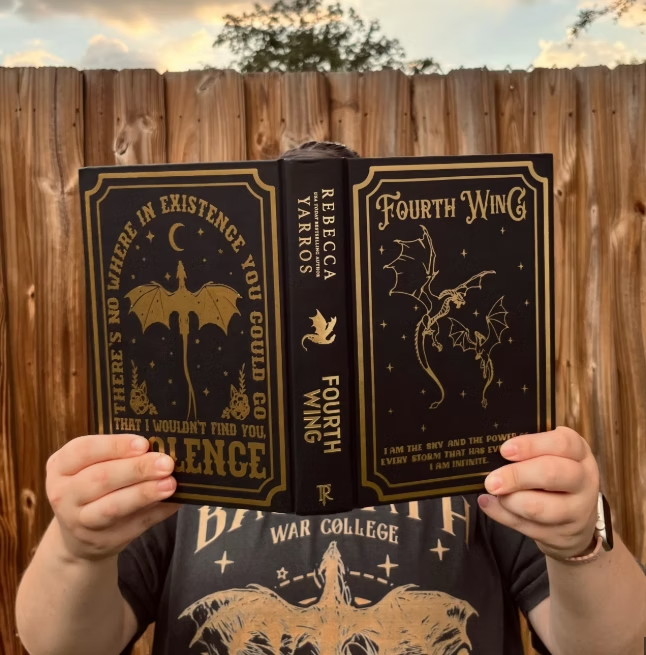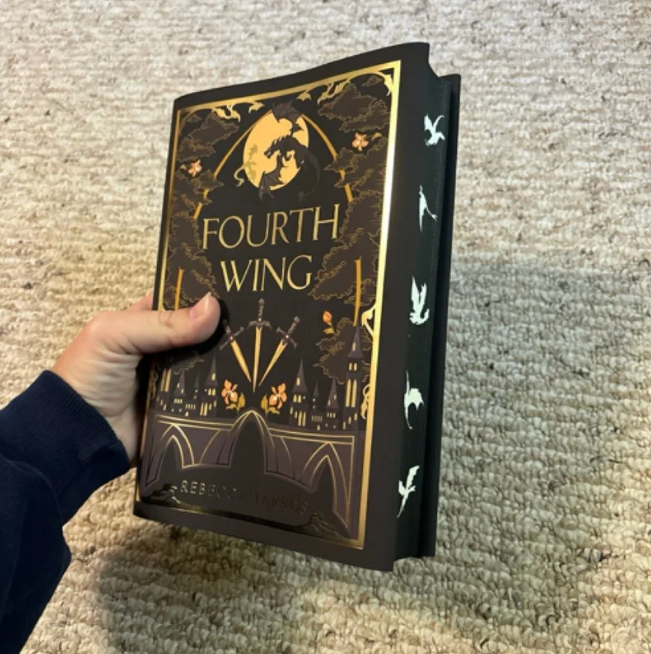Feel This Book: The Tactile Renaissance of Print in a Digital Age
- Kevin Abergel

- Aug 12
- 12 min read

A Dragon on the Page
One chilly morning in 2023, a curious line formed outside a bookstore in Michigan. Instead of clamoring for a celebrity author’s signature or a new gadget, the mostly Gen-Z crowd waited for a special hardcover edition of a fantasy novel. This was no ordinary book: its pages were edged in matte black, with tiny silver dragons stenciled across the sides, and its cover lettering shimmered in foil. When Fourth Wing finally hit shelves, complete with those black, dragon-stamped page edges, it flew off them . The young readers did not just want the story; they wanted the book itself, a beautiful, touchable artifact. In an era of e-books and endless digital content, the sight of teenagers lining up for an elaborately embellished hardcover was as unexpected as a dragon in a coffee shop. Why would a generation raised on glowing screens be so enchanted by ink on paper and the glint of foil? The answer lies in a surprising convergence of psychology, history, and industry that is breathing new life into the printed page.
The Comeback Nobody Predicted
Not long ago, many tech pundits were writing epitaphs for the printed book. When e-readers burst onto the scene in the late 2000s, it seemed as if paper books might soon go the way of parchment scrolls. By the mid-2010s, e-book sales were surging and a paperless future felt inevitable. Publishers closed down print imprints, bookstores struggled, and a “digital first” mantra took hold. Yet here we are, in the 2020s, witnessing what can only be described as a renaissance of the printed book, a comeback nobody predicted. In 2021, U.S. print book sales hit a record high of over 843 million units, and 2022 clocked in at nearly 789 million, the second-highest ever . Far from fading away, printed books have held roughly three-quarters of the market by revenue in recent years, with e-books hovering around only 20% . In fact, the growth of e-books plateaued; about 30% of American adults read an e-book in 2023, a figure unchanged for a decade, whereas more than 65% read a print book that year . The humble hardcover and paperback, it turns out, are not relics at all; they are resilient survivors.
What is driving this turn of events? Interestingly, it is not just nostalgic Boomers keeping print alive. Younger readers have embraced physical books with fervor. A Pew Research survey found that nearly 70% of 18–29 year-olds had read a print book in the past year, compared to 42% who read an e-book . Generation Z, born digital, is choosing analog when it comes to books. “There is nothing like opening up a real book on a couch or beach,” one 23-year-old reader explained, noting she loves the smell of paper and the ritual of browsing a bookstore . Even students attest that reading in print helps them focus better and gives their eyes a break from screens . The data backs up the trend: in the UK, people aged 13–24 made 80% of their book purchases in print and only 14% in digital form over a recent year . What started as a trickle, a few hipsters and bookstagrammers showing off vintage hardcovers, has swelled into a full-blown movement of young bookworms turning away from pixels and back to paper. In hindsight, the “death of the book” was a myth; if anything, print was regrouping for a new chapter.
The Psychology of Touch and Time
Underlying this revival is something fundamental: the human need to touch. Reading is not only a visual act; it is a physical one. Think of the satisfying heft of a hardcover, the texture of a dust jacket under your fingers, the gentle whoosh of flipping pages. Our senses are telling us what science is now confirming. Cognitive researchers have found that people often

absorb and recall information better from physical pages than from screens . One study suggests comprehension can be six to eight times better with a paper book than an e-reader . Part of the reason is tactile and spatial. As we turn pages, our brain forms a kind of “mental map” of the text, a neurological index linking content to its place on a page . With a real book, you might remember that a pivotal quote was halfway down on the left-hand page, maybe a quarter-inch from the book’s thickness, a subconscious anchor that aids memory. A glowing scroll of pixels offers no such landmarks. In a sense, an e-book always feels like one long page, while a print book gives the mind physical reference points.
The advantages of touch go beyond memory. Holding a book is an experience in itself, one that engages what psychologists call embodied cognition. The weight of a tome, the roughness or smoothness of paper, even the act of physically turning pages, all send signals to the brain that something real and important is at hand . Studies in consumer psychology show that physical touch can literally increase our sense of ownership and value for an item; simply handling a product makes us more likely to want it and be willing to pay for it . This “endowment effect” might explain why a book you have lovingly thumbed through feels priceless compared to a digital file. With a physical book, you develop a tactile relationship; you feel your progress as the unread pages in your right hand slowly dwindle and the story nears its end. Time behaves differently with a book in hand. It slows down, inviting immersion, away from the cacophony of notifications and multitasking that often plague screen reading . Readers often describe print as an escape or a “digital detox” . Without the temptations of hyperlinks or the glare of a screen, many find it easier to lose themselves in the narrative. In effect, the printed book has become a refuge for focus and contemplation in a distracted age.
And then there is the sheer sensory pleasure of it. “The smell of real books is so personal,” one young reader said , a sentiment anyone who has inhaled the vanilla-almond scent of old paper can appreciate. The feel of a high-quality hardcover, the kind with a velvety soft-touch coating, can trigger a small jolt of joy. (As one print shop expert put it, “Soft touch feels like you’re petting velvet” .) A book can delight the eyes too, in ways a backlit tablet cannot: deckle-edged pages, the warm cream of good paper stock, or an artfully designed cover that catches the light just so. All these tactile and visual cues signal quality and care. They tell our brains that this object is worth savoring. It is no surprise that many readers describe print books as offering a deeper emotional connection than digital, something to curl up with, share, display, and treasure. Reading a physical book is multisensory. It engages touch, sight, smell, even sound (that crack of a new spine). In a world increasingly dominated by the intangible, such sensory richness is not just pleasant; it is profoundly comforting and engaging.
Beauty on the Shelf: Embellishments and Exclusivity
If the resurgence of print were only about nostalgia and cognitive science, it might have stalled out as a modest countertrend. Publishers, booksellers, and readers themselves have supercharged it by reimagining books as art objects and coveted collectibles. In recent years, the publishing industry has leaned into the idea that a physical book is not just a vessel for words but a luxury experience. Special editions, once reserved mostly for classics and anniversaries, have exploded in number. Now even buzzy debut novels and bestsellers are getting released in ornately crafted editions featuring sprayed or gilded page edges, foil-stamped covers, intricate illustrations, and textured finishes.
Publishing has long catered to hardcore collectors with beautifully bound backlist titles, turning novels into decorative objects for proud display. What is new is how mainstream and youth-driven this phenomenon has become. That dragon-emblazoned Fourth Wing first printing was just the spark. Fueled by social media and fan enthusiasm, we are now in a boom of what might be called boutique books.
A major force behind this boom has been the rise of online book communities like

Bookstagram and BookTok. On these visual platforms, aesthetic reigns supreme. Enthusiastic readers, especially in the romance and fantasy fandoms, do not just talk about a novel’s plot; they show off how gorgeous it looks on their shelf. This has driven demand for ever more distinctive physical books. Publishers have taken note: “Today’s fans want a gorgeous package as well,” says one publishing executive, noting that just a few years ago “bonus content” might have sufficed, but now the cover design and production quality itself must dazzle.
In the romance genre in particular, devoted fans have essentially created a collectors’ culture around books. They celebrate limited editions like trophies in a community, sharing photos of gilded covers and color-coordinated shelf displays. As Gallery Books editor Carrie Feron observed, these readers have become more vocal and communal: “There’s a celebration and community in romance now… one of the ways they’re expressing it is collecting and showing their shelves.” Loving a book today is not just about the story; it is about loving the object and what it represents: fandom, identity, and belonging.
The result is a flurry of special releases that would have been unthinkable a decade ago. Book subscription services and indie booksellers offer exclusive runs with custom cover art, metallic foils, and even scented pages. Publishers themselves have gotten bolder, seeing that readers will clamor for these lavish editions. For example, the publisher of Fourth

Wing printed its first run with those striking black sprayed edges adorned by dragon silhouettes, a decision that generated so much buzz and envy on social media that copies became instant collector’s items. A first edition of that book, which sold for $30 new, now can fetch ten times that on the resale market due to its unique embellishments and scarcity.
Social media accelerates these trends. On TikTok, a video of a particularly stunning book, perhaps edges painted like a galaxy or a cover that gleams with holographic foil, can go viral, reaching millions of potential readers. “A beautiful package can create buzz for a title before anyone has even had the chance to read it,” notes one publisher, emphasizing that in the Instagram and TikTok era, aesthetics sell. It is a feedback loop: readers share beautiful books, which makes others desire them, which encourages publishers to produce more of them.
Printing Presses Get Their Groove Back
Behind this renaissance in book beauty is a quieter revolution in the printing industry. For commercial printers, who a decade ago feared that digital media would gut their business, the new demand for high-quality, embellished print has been a shot of adrenaline and a call to innovate. Print shops, big and small, are investing in cutting-edge print embellishment technologies to meet publishers’ and consumers’ appetites for tactile effects. In fact, the global market for print embellishments is growing at an estimated 6 to 8 percent annually, transforming what might have been a stagnating trade into a growth sector. The playbook for printers now reads: do not just put ink on paper, add value, add experience.
Take book covers. Printers report that “book covers are coming back in a big way.” One industry veteran notes that nowadays “you will see a matte lamination and some kind of foil, raised element, and varnish to create a really highly embellished product” on a novel’s cover. The new bestsellers often gleam and shine, literally. To achieve these effects efficiently, printing companies have turned to new digital finishing equipment that can do spot varnishing, embossing, and foil in a single pass. Not long ago, adding a foil stamp or UV gloss pattern to a cover was a labor-intensive, expensive affair requiring custom dies and long setup times. It was feasible only for very large print runs. Now, with digital embellishment presses, a printer can economically produce even a few hundred special-edition covers with elaborate finishes. One company in Minnesota installed a digital foil and varnish machine and suddenly found they “could not put foil on enough things fast enough” to satisfy demand. The investment paid off so well they bought a second one. This story is echoed across the industry: printers who once churned out commodity paperbacks are reinventing themselves as craftsmen of coveted, high-touch products.
These technologies are themselves marvels of innovation. Embellishment presses can lay down precise layers of clear polymer, foil, and even tactile textures under computer control. This means no plates, no screens, and no dies. Designs can be swapped on the fly, enabling personalization and short runs. The ability to easily add tactile and visual effects to books is opening creative doors that were previously impractical.
From the printer’s perspective, these premium techniques also offer a lifeline in terms of economics. Customers are willing to pay more for special finishes, sometimes significantly more. One industry survey found that print buyers were willing to pay between 24 and 89 percent higher prices for projects with embellishments compared to standard print. Those are remarkable premiums in an industry known for tight margins. By selling texture, shine, and artistic flair, printers are selling emotion and attention, two scarce commodities in the digital age, and clients are gladly paying for it.
More Than a Fad?
Every revival invites the question: is this just a passing fashion or a lasting shift? Some of the hype is driven by trends on TikTok and Instagram, which are known for their short-lived obsessions. It is possible that in a few years the novelty of sprayed edges and foil-stamped covers could wear off, and some readers may drift back to the convenience of digital reading. Yet multiple signs point to something deeper. The cognitive focus, tactile pleasure, and freedom from distraction that physical books offer are not transient fads but rooted in human psychology. The current generation of young readers embracing print grew up with screens. Their preference for paper may be a lasting vote for balance and sanity in a wired world rather than a quirky rebellion. “It feels like a treat, and you cannot replicate this experience by simply downloading it,” one 23-year-old book lover explained.
The integration of print and digital in the publishing ecosystem also suggests longevity. This is not an either-or scenario but a new equilibrium. E-books and audiobooks continue to serve readers who value instant access and portability. Physical books are carving out a role less about basic information delivery and more about experience delivery. Print books have been repositioned from a utilitarian good to something closer to a luxury good, not in terms of price but in terms of richness of experience. Vinyl records offer a parallel. Streaming music is ubiquitous and convenient, but vinyl has surged among those who crave a fuller sensory and collectible experience.
Culturally, the renewed embrace of physical books aligns with a broader pushback against the ephemerality of digital life. Owning a well-made book is an act of resistance to fleetingness. It says: here is something I care about enough to give space on my shelf, to return to, to share with friends, or to pass down one day. There is durability in print that bytes cannot match. People sense this. A richly bound book has heft in both the literal and figurative sense. Owning it feels different than clicking “Buy now” on a file.
Conclusion: The Story in Our Hands
The resurgence of paper books may not have been sparked by a single moment but by a convergence of many small sparks. A viral TikTok video of a gilded-edged novel, a study showing the mental benefits of reading on paper, a printer’s new machine making it easier to emboss covers, and a pandemic lockdown that reminded people how comforting a bookshelf can be all contributed. The book itself is being redefined. It is not merely the content that matters, but the container. The feel of a cover, the weight of the paper, the beauty of the design, even the smell of the ink are part of the storytelling now.
As the young readers clutching their dragon-edged novels in that Michigan bookstore showed, a book can offer an experience that no e-reader can emulate. It engages the mind and the body. It is both an intellectual journey and a tactile one. The resurgence of the printed book, embellished and enhanced, is a story of how modern people found their way back to an old friend, bringing new creativity along with them. It is a reminder that sometimes progress is not about rejecting the past for a digital future. Sometimes it is about fusing the best of both. A beautifully produced book today might have a companion e-book and audiobook, but the physical volume is now the deluxe edition of the story, the one that engages our senses and our hearts most deeply.
Back in that bookstore line, each person who left with the hefty hardcover in hand was not just buying a story to read; they were buying a piece of magic to feel. As one cover designer quipped recently, “we are in the business of making people fall in love at first touch.” The digital revolution promised to make reading infinitely convenient. The print renaissance is reminding us why reading was, and is, magical. The two will co-exist, each serving different needs. But when it comes to leaving an impression, nothing does it quite like a book you can hold, admire, and even run your fingers over. The story is not just on the page anymore; the story is the page, the cover, the object itself. And that story is still being written, one foil-stamped, textured, velvety page at a time.
References
World Economic Forum. (2023, March 14). Gen Zers are bookworms — but say they’re shunning e-books because of eye strain, digital detoxing and their love for libraries. World Economic Forum. https://www.weforum.org/stories/2023/03/gen-zers-are-bookworms-but-say-theyre-shunning-e-books-because-of-eye-strain-digital-detoxing-and-their-love-for-libraries/
Publishers Weekly. (2023, January 5). Print book sales fell 6.5% in 2022. Publishers Weekly. https://www.publishersweekly.com/pw/by-topic/industry-news/financial-reporting/article/91245-print-book-sales-fell-6-5-in-2022.html
Wikipedia contributors. (2024, December 17). Entangled Publishing. In Wikipedia. https://en.wikipedia.org/wiki/Entangled_Publishing
PangoBooks. (n.d.). Sprayed edition: Fourth Wing. PangoBooks Blog. Retrieved August 12, 2025, from https://pangobooks.com/blog/sprayed-edition-fourth-wing
Shelf Awareness. (2025, January 21). More than a thousand midnight release parties for Onyx Storm. Shelf Awareness. https://www.shelf-awareness.com/theshelf/2025-01-21/more_than_a_thousand_midnight_release_parties_for_onyx_storm.html
.png)


Comments